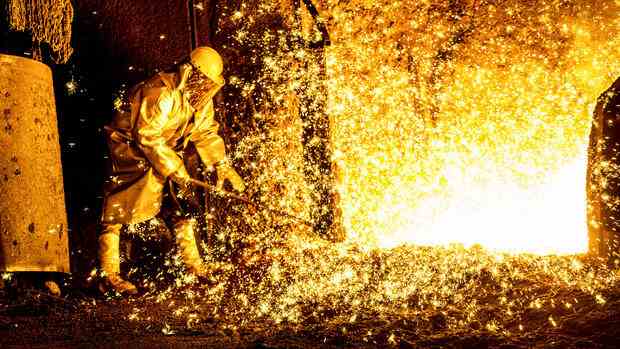The classic blast furnace route for steel production must be replaced by new processes.
(Photo: Marc-Steffen Unger)
Berlin Federal Minister of Economics Robert Habeck (Greens) wants to enable industry to switch to climate-neutral production processes with billions in aid. The draft of a “Guideline for the promotion of climate-neutral production processes in industry through climate protection agreements” available to the Handelsblatt provides information on how the system should work. Addressees are “emission-intensive industrial sectors”. These include steel, cement and chemicals.
The paper states that climate-friendly production is often so cost-intensive that “companies cannot switch to it because otherwise they would have too great a cost disadvantage in competition”. Investments in climate-friendly processes are therefore “at least highly risky and are still too often omitted today”.
This is the point where future climate protection agreements that are concluded between the public sector and individual companies should come into play. The principle: On the basis of these contracts, companies from energy-intensive industrial sectors are compensated for the additional costs that the corporations incur as a result of the fact that they set up and operate more climate-friendly alternatives compared to conventional plants.
The climate protection agreements are to have a term of 15 years. In ministry circles it is said that “a double-digit billion amount will be made available for climate protection contracts so that energy-intensive industry can produce in a climate-friendly manner”. The concept is now going to the departmental vote. The first contracts are expected to be signed in early 2023.
Top jobs of the day
Find the best jobs now and
be notified by email.
Habeck’s project thus makes new technologies marketable. Risks and ultimately costs are becoming more calculable, which also enables financing through equity and debt capital in climate-friendly technologies.
According to the draft directive, “additional costs for the manufacture of products” are eligible for funding. “The hydrogen used must meet the requirements for green hydrogen or blue hydrogen,” the draft goes on to say. “Electricity used must have been generated entirely from renewable sources.”
The steel industry in particular is waiting for climate protection agreements. Companies like Thyssen-Krupp, Salzgitter and Arcelor-Mittal have made investment decisions worth billions in recent months to switch to climate-friendly production processes. The CO2-intensive steel production via the blast furnace route is to be replaced by the so-called direct reduction process.
If climate-neutral hydrogen is used for the direct reduction process, CO2-neutral steel is produced. However, this steel is significantly more expensive than steel from conventional production. The gap is to be closed by climate protection agreements.
If you want to conclude a climate protection agreement, you have to apply to the Federal Ministry of Economics in a call for tenders. Whoever asks for the least help, saves the most greenhouse gases and consumes the least energy is awarded the contract.
The federal government wants to keep repayments open
The contract stipulates that repayments may also be required. This can be the case, for example, if conventional production processes become more expensive due to rising prices in European emissions trading. Then the gap to be closed via the climate protection agreement will be smaller. “This reduces the burden on the state budget,” says the draft. The contracts also take into account that climate-friendly products can achieve a higher price. According to the directive, 70 percent of this additional revenue for the company is skimmed off in the contracts.
If electricity is used in production, it must come from renewable sources such as wind or sun. Hydrogen, on the other hand, is allowed to be produced with the help of natural gas, for example. Condition: The resulting CO2 must be separated and safely stored. This so-called CCS technology (Carbon Capture and Storage) is very controversial in Germany. However, there has recently been movement in the debate about CCS. In the climate protection program, the Ministry of Economics had already paved the way for “blue” hydrogen.
A similar infrastructure for CCS technology is also to be set up in Germany.
(Photo: Klaus Stratmann, Handelsblatt)
This does not necessarily mean that the CO2 in Germany is pressed into former natural gas deposits. Countries like the Netherlands or Norway want to turn this into a business model and also absorb CO2 from Germany. For a transitional period, blue hydrogen is the only feasible way for industry to achieve the goal of climate neutrality.
Green hydrogen, produced by electrolysis using electricity from renewable sources, is unlikely to be available in sufficient quantities to meet industry needs within the next few years. In order to have relevant quantities of green hydrogen available as quickly as possible, the federal government is working on concepts that should enable the import of green hydrogen from countries such as Australia, Chile, Morocco or Saudi Arabia.
Industry is responsible for around a quarter of Germany’s greenhouse gas emissions. At the top are the steel, chemical and cement industries. Germany wants to be climate neutral by 2045. Until then, the bottom line is that no more greenhouse gases should be released into the atmosphere.
More: Germany could obtain hydrogen from these countries in the future
